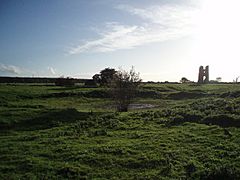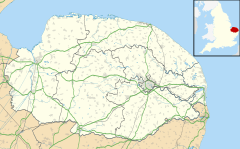Godwick facts for kids
Quick facts for kids Godwick |
|
|---|---|
 The church tower at the site of Godwick village |
|
| District | |
| Shire county | |
| Region | |
| Country | England |
| Sovereign state | United Kingdom |
| EU Parliament | East of England |
Godwick is a "lost" or deserted village in the county of Norfolk, England. It is located south of Fakenham, between the villages of Tittleshall and Whissonsett.
Norfolk has over 200 deserted villages. However, most of these old sites have been destroyed over time. This happened because of farming, wars, or other land uses. Only a few places still show clear signs of their past. Godwick is special because its old earthworks are very well preserved. This is because sheep graze there, and the land has never been disturbed by ploughing.
Today, Godwick is one of the best examples of a deserted village in Norfolk. It is also the only one that is open to the public. The site is managed with English Heritage. You can visit Godwick between April and September, from 9:30 am until dusk. There are information panels on site. These panels show aerial photos, maps, and plans of this lost village. The earthworks at Godwick are a Scheduled Ancient Monument. This means it is protected by law. It is against the law to disturb the site or use metal detectors without permission from English Heritage.
The Village's Early Days
Godwick was first settled a very long time ago, during the Anglo-Saxon period. By the 1400s, Godwick was a small village. It was a fairly stable community, but it was not as rich as nearby settlements.
The village started to decline sharply in the 1400s. A series of bad harvests made it hard for people to grow enough food. The heavy clay soil was also difficult to farm. These problems caused the number of people living there to shrink. In 1428, there were fewer than ten households. By 1508, a survey showed that 11 out of 18 properties were empty. Three others had no land attached to them. This survey also showed that a church was located to the south. There was also a watermill with a millpond.
By 1595, Godwick was almost completely deserted. Its final decline was recorded on a map in 1596. At that time, only three or four houses were left. The church tower had also fallen down.
What Godwick Looks Like Today
Today, you can still see parts of the medieval village. There is a sunken road that runs from east to west. Two other roads branch off to the south. Along both sides of the main road, you can see banks and ditches. These once separated the individual house plots. About ten of these plots can still be seen.
The church stood within its own area, between the roads. At the eastern end of the site, the village road ran along a dam. This dam held back a millpond, with a small watermill at its end. Farm buildings now cover the line of the dam.
In 1981, a remaining part of the church tower collapsed. This 13th-century church tower had been rebuilt as a brick and flint "folly." A folly is a building built just for decoration. This happened when the church was taken down in the 1600s. This folly might have been part of a plan to design the landscape around the later Godwick Manor. When the tower collapsed in 1981, people found evidence of a Norman church among the rubble.
You can also still see a large 13th-century red-brick barn on the site. It has a fancy front and was built over the old village street. During the time of King Charles II, 200 soldiers were stationed there. You cannot go inside the barn, but you can walk around it. You can also admire its beautiful windows.
The Later Godwick Manor
In 1585, a grand brick manor house was built in the middle of the deserted village. Sir Edward Coke, a very important lawyer and judge, bought the estate in 1580. He built this house.
The manor house was shaped like the letter "E." It had an impressive two-story porch and many windows. Sadly, the ruins of this house were pulled down in 1962. Today, you can just make out its square shape as slight bumps in the grass. The manor had a walled yard and an entrance to the north. Around the main hall, there were formal gardens and other enclosed areas.
Godwick Manor was also the birthplace of Admiral Sir William Hoste. He was a famous naval officer.


